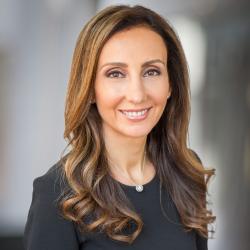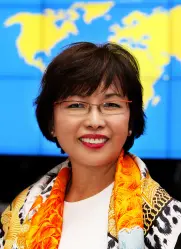As the third calendar year of the pandemic begins, 2022 promises to be an important one—especially for education. Around the world, education systems have had to contend with sporadic closures, inequitable access to education technology and other distance learning tools, and deep challenges in maintaining both students’ and teachers’ physical and emotional health. At the same time, not all of the sudden changes precipitated by the pandemic have been bad—with some promising new innovations, allies, and increased attention on the field of global education emerging over the past three years. The key question is whether 2022 and the years ahead will lead to education transformation or will students, teachers, and families suffer long-lasting setbacks?
In the Center for Universal Education, our scholars take stock of the trends, policies, practices, and research that they’ll be closely keeping an eye on this year and likely in the many to come.
 Emily Gustafsson-Wright, Senior Fellow
Emily Gustafsson-Wright, Senior Fellow
More than ever, in 2022 it will be critical to focus on strengthening the fabric of our global education system in order to achieve positive outcomes—particularly through an increased focus on data-informed decisionmaking. We have seen a renewed focus on different forms of data that are critical to enhanced education outcomes, such as real-time performance data, which allow teachers and other decisionmakers to course-adjust to the needs of learners to better support their educational journeys. Additionally, high-quality program cost data are needed for decisionmakers to plan, budget, and choose the most cost-effective interventions.
One way we are seeing these areas strengthened is through innovative financing for education, such as impact bonds, which require data to operate at full potential. This year, pooled funding through outcomes funds—a scaled version of impact bonds—should make a particularly big splash. The Education Outcomes Fund organization is slated to launch programs in Ghana and Sierra Leone, and we also expect to see the launch of country-specific outcomes funds for education such as OFFER (Outcome Fund For Education Results) in Colombia, the Back-to-School Outcomes Fund in India, and another fund in Chile. At the Center for Universal Education, we will be following these innovations closely and look forward to the insights that they will bring to the education sector.
 Helen Shwe Hadani, Fellow
Helen Shwe Hadani, Fellow
As we look ahead to 2022, one continued challenge for many families is navigating the uncharted territory of supporting children’s learning with a growing number of school closures. But while the pandemic forced an abrupt slowdown in modern life, it also provided an opportunity to reexamine how we can prioritize learning and healthy development both in and out of school. Moreover, the cascading effects of the pandemic are disproportionally affecting families living in communities challenged by decades of discrimination and disinvestment—and are very likely to widen already existing educational inequities in worrisome ways.
One innovative approach to providing enriching learning opportunities beyond school walls that address the inequities in our current systems is Playful Learning Landscapes (PLL)—installations and programming that promote children and families’ learning through play in the public realm. A current focus for PLL at Brookings is measuring the impact of these spaces to show that PLL works and to garner greater investment in them. To that end, Brookings and its partners developed a framework and an initial set of indicators from both the learning science and placemaking perspectives to help assess the positive effects of PLL on learning outcomes, as well as its potential to enhance social interaction and public life in revitalized spaces. The framework will continue to evolve as we learn from communities that are testing the expansion and adaptation of PLL—this important work is just beginning.
 Kathy Hirsh-Pasek, Senior Fellow
Kathy Hirsh-Pasek, Senior Fellow
The pandemic highlighted several trends in education that promise to be the focus of future policy and practice in 2022 and beyond: the importance of skills that supplement the learning of content, systemic inequities in education systems, and the role of digital technology in the education of the future. It has become increasingly clear that the memorization of content alone will not prepare children for the jobs and society of the future. As noted in a Brookings report “A new path for education reform,” in an automated world, manufacturing jobs and even preliminary medical diagnoses or legal contracts can be performed by computers and robots. Students who can work collaboratively—with strong communication skills, critical thinking, and creative innovation—will be highly valued. Mission statements from around the globe are starting to promote a “whole child” approach to education that will encourage the learning of a breadth of skills better aligning the education sector with needs from the business sector.
The past year also demonstrated weaknesses and inequalities inherent in remote learning that I’ll be closely tracking in the years to come. In fact, the Centers for Disease Control and Prevention suggested that virtual learning presents risks to social-emotional learning. Further, research suggests that academic progress during the pandemic slowed such that students demonstrated only 35 to 50 percent of the gains they normally achieve in mathematics and 60 to 68 percent in reading. The losses are not experienced uniformly, with children from underresourced environments falling behind their more resourced peers.
The failure of remote learning also raises questions about the place of digital learning in the classroom. Learning will become more and more hybrid over time, and keeping an eye on advances in technology—especially regarding augmented reality and the metaverse—will be particularly important, as both have real consequences for the classrooms.
 Maysa Jalbout, Nonresident Fellow
Maysa Jalbout, Nonresident Fellow
In 2022, I’ll be focusing on one group of children in particular–refugees–who are among those children who have historically had the least access to preprimary education. The pandemic has affected them disproportionally, as it pushed them and their families into poverty and deprived them from most forms of education during the school closures.
While much more investment in early childhood education research and evaluation is needed to improve evidence and channel scarce resources effectively, there are a few important efforts to watch. A report commissioned by Theirworld last year provided an overview of the sector and focused on a critical gap and opportunity to address the inequity of access to early childhood education in refugee settings by better supporting teachers and community workers. This year, Theirworld and partners will pursue two of the report’s recommendations–making the science of early childhood brain development widely accessible in refugee communities and building the evidence base on what works in supporting early childhood education teachers and the young refugee children they teach.
The report was informed by existing initiatives including Ahlan Simsim, which in 2017 received the largest known grant to early education in a humanitarian context. While the evaluation of Ahlan Simsim will not be complete until two more years, the Global Ties for Children research center, Sesame Workshop, and the International Rescue Committee will share critical insights into their learning to date in a forthcoming episode of the podcast the Impact Room.
 Beth King, Nonresident Senior Fellow
Beth King, Nonresident Senior Fellow
This coming year I’ll be focused on how education systems can prepare for future disruptions, whatever the cause, with more deliberateness. The past two years of the COVID pandemic have seen education systems throughout the globe struggle to find ways to continue schooling. Additionally, there have been other public health crises, natural disasters such as earthquakes, floods, and severe storms, and wars and terrorism in different parts of the world that have gravely tested school systems’ ability to minimize the cost of catastrophes on students and teachers. Finding safer temporary learning places outside the school and using technologies such as radio, TV broadcasts, and online learning tools have helped, but quick fixes with little preparation are not effective approaches for sustaining and advancing learning gains.
In the age of broadcast and digital technologies, there are many more ways to meet the challenges of future emergency situations, but life- and education-saving solutions must be part of the way school systems operate—built into their structures, their staffing, their budgets, and their curricula. By preparing for the emergencies that are likely to happen, we can persevere to reach learning goals for all children.
 Jennifer O’Donoghue, Fellow
Jennifer O’Donoghue, Fellow
By the close of 2021, a number of studies began to document the impact of COVID-19 on girls’ educational trajectories across the Global South. These studies point to promising trends–lower than expected dropout rates and reenrollment rates similar to (if not greater than) those of boys–while still highlighting the particular challenges faced by adolescent girls and girls living in poverty, conflict, and crisis.
In 2022, it will be critical to continue to generate more nuanced evidence—carefully considering questions such as “for which girls,” “where,” “when,” and “why.” And then we must put this knowledge to use to protect and promote girls’ and young women’s rights not just to education, but to participate and thrive in the world around them. Ensuring that marginalized girls and young women become transformative agents in improving their lives and livelihoods—as well as those of their families and communities—requires us to develop new strategies for learning and acting together.
At the Center for Universal Education, this means strengthening our work with local leaders in girls’ education: promoting gender-transformative research through the Echidna Global Scholars Program; expanding the collective impact of our 33 Echidna alumni; and co-constructing a learning and action community to explore together how to improve beliefs, practices, programs, and policies so that marginalized adolescent girls’ can develop and exercise agency in pursuing their own pathways.
 Brad Olsen, Senior Fellow
Brad Olsen, Senior Fellow
Going into year three of COVID-19, in 2022 I’m interested to see whether countries will transform their education systems or largely leave them the way they are. Will leaders of education systems tinker around the edges of change but mostly attempt a return to a prepandemic “normal,” or will they take advantage of this global rupture in the status quo to replace antiquated educational institutions and approaches with significant structural improvement?
In relation to this, one topic I’ll be watching in particular is how countries treat their teachers. How will policymakers, the media, parent councils, and others frame teachers’ work in 2022? In which locations will teachers be diminished versus where will they be defended as invaluable assets? How will countries learn from implications of out-of-school children (including social isolation and child care needs)? Will teachers remain appreciated in their communities but treated poorly in the material and political conditions of their work? Or will countries hold them dear—demanding accountability while supporting and rewarding them for quality work?
 Jordan Shapiro, Nonresident Fellow
Jordan Shapiro, Nonresident Fellow
I’m interested in learning more about how pandemic lockdowns have impacted students. So far, we’ve only gotten very general data dealing with questions that are, in my opinion, too simple to be worthwhile. It’s all been about good and bad, positive and negative, learning loss and achievement. But I’ll be watching for more nuanced studies, which ask about specific ways increased time away from school has impacted social-emotional development. How do those results differ between gender, race, socioeconomic status, and geographic location? I suspect we’re going to learn some things about the relationship between home environment and school environment that will challenge a lot of our taken-for-granted assumptions.
 Emiliana Vegas, Senior Fellow and Co-Director
Emiliana Vegas, Senior Fellow and Co-Director
In 2022, I’ll be tracking emerging evidence on the impact of the COVID-19 school closures on children and youth. Several researchers, including my co-authors and me, have provided estimates of the school closures’ impact on student learning losses, unemployment, future earnings, and productivity globally. But only recently are researchers analyzing actual evidence of learning losses, and an early systematic review finds that “Although robust and empirical research on COVID-19-related student learning loss is limited, learning loss itself may not be.”
Likewise, there is little rigorous reviews of remote learning tools’ and platforms’ impact on student learning during the school closures. After the pandemic, it is almost certain that remote and hybrid learning will continue—at a minimum occasionally and often periodically—in primary, secondary, and post-secondary education. It is urgent that we build the evidence base to help education decisionmakers and practitioners provide effective, tailored learning experiences for all students.
Finally, a key issue for education is how to redesign curricula so that this generation (and future generations) of students gain a key set of skills and competencies required for technologically-advancing labor markets and societies. While foundational literacy and numeracy skills continue to be essential for learning, a strong foundational knowledge of science, technology, engineering, and mathematics is ever more important in the 21st century, and I look forward to contributing research this year to help make the case for curricula redesign efforts.
 Rebecca Winthrop, Senior Fellow and Co-Director
Rebecca Winthrop, Senior Fellow and Co-Director
I will be interested to see how parent-teacher relationships progress after the pandemic has (hopefully) faded into the background. COVID-19 has had an inescapable impact on the way we deliver education globally, but none more so than on how education leaders and teachers interact with students and their families.
For the past three years, I have been studying family-school collaboration. Together with my colleagues and partners, we have surveyed nearly 25,000 parents and 6,000 teachers in 10 countries around the world and found that the vast majority of teachers, parents, and caregivers want to work together more closely. Quality family-school collaboration has the potential to significantly improve educational outcomes, spur important discussions on the overall purpose of school, and smooth the path for schools and families to navigate change together. From community schools in New Mexico to text message updates from teachers in India, new innovations are popping up every day—in every corner of the world. I’m excited to see what the future holds for family-school collaboration!












Commentary
Global education trends and research to follow in 2022
January 24, 2022